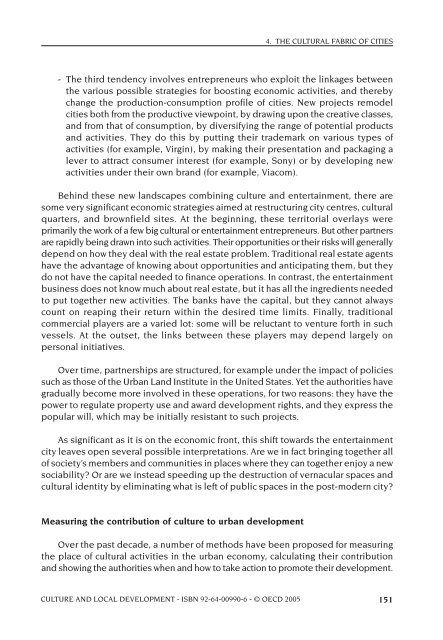OECD Culture and Local Development.pdf - PACA
OECD Culture and Local Development.pdf - PACA
OECD Culture and Local Development.pdf - PACA
You also want an ePaper? Increase the reach of your titles
YUMPU automatically turns print PDFs into web optimized ePapers that Google loves.
4. THE CULTURAL FABRIC OF CITIES<br />
- The third tendency involves entrepreneurs who exploit the linkages between<br />
the various possible strategies for boosting economic activities, <strong>and</strong> thereby<br />
change the production-consumption profile of cities. New projects remodel<br />
cities both from the productive viewpoint, by drawing upon the creative classes,<br />
<strong>and</strong> from that of consumption, by diversifying the range of potential products<br />
<strong>and</strong> activities. They do this by putting their trademark on various types of<br />
activities (for example, Virgin), by making their presentation <strong>and</strong> packaging a<br />
lever to attract consumer interest (for example, Sony) or by developing new<br />
activities under their own br<strong>and</strong> (for example, Viacom).<br />
Behind these new l<strong>and</strong>scapes combining culture <strong>and</strong> entertainment, there are<br />
some very significant economic strategies aimed at restructuring city centres, cultural<br />
quarters, <strong>and</strong> brownfield sites. At the beginning, these territorial overlays were<br />
primarily the work of a few big cultural or entertainment entrepreneurs. But other partners<br />
are rapidly being drawn into such activities. Their opportunities or their risks will generally<br />
depend on how they deal with the real estate problem. Traditional real estate agents<br />
have the advantage of knowing about opportunities <strong>and</strong> anticipating them, but they<br />
do not have the capital needed to finance operations. In contrast, the entertainment<br />
business does not know much about real estate, but it has all the ingredients needed<br />
to put together new activities. The banks have the capital, but they cannot always<br />
count on reaping their return within the desired time limits. Finally, traditional<br />
commercial players are a varied lot: some will be reluctant to venture forth in such<br />
vessels. At the outset, the links between these players may depend largely on<br />
personal initiatives.<br />
Over time, partnerships are structured, for example under the impact of policies<br />
such as those of the Urban L<strong>and</strong> Institute in the United States. Yet the authorities have<br />
gradually become more involved in these operations, for two reasons: they have the<br />
power to regulate property use <strong>and</strong> award development rights, <strong>and</strong> they express the<br />
popular will, which may be initially resistant to such projects.<br />
As significant as it is on the economic front, this shift towards the entertainment<br />
city leaves open several possible interpretations. Are we in fact bringing together all<br />
of society’s members <strong>and</strong> communities in places where they can together enjoy a new<br />
sociability? Or are we instead speeding up the destruction of vernacular spaces <strong>and</strong><br />
cultural identity by eliminating what is left of public spaces in the post-modern city?<br />
Measuring the contribution of culture to urban development<br />
Over the past decade, a number of methods have been proposed for measuring<br />
the place of cultural activities in the urban economy, calculating their contribution<br />
<strong>and</strong> showing the authorities when <strong>and</strong> how to take action to promote their development.<br />
CULTURE AND LOCAL DEVELOPMENT - ISBN 92-64-00990-6 - © <strong>OECD</strong> 2005 151














